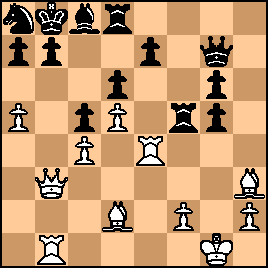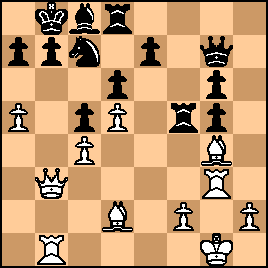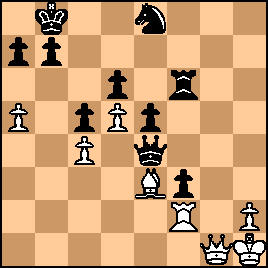Oct-02-22
 | | Fusilli: After 25...Rf5, this seems to be a crucial moment:

click for larger viewWhite played the reasonable 26.Bxf5, which turns out to be inferior. Better is to notice that the exchange offer cannot be rescinded and wait to take the rook at the right moment. The 6-second Stockfish analysis starts with: +0.58 (27 ply) 26.Re3 Qh7 27.Bg4 Nc7 28.Rh3 Qg7 29.Rg3:

click for larger view
Now white will take the exchange *and* the g5 pawn. It looks much better than what happened in the game! After 42...Qe4:

click for larger view
White's position is absolutely hopeless, but I can't avoid a chuckle from what followed: 43.Qg8 Rf8! And taking the rook means Qb1+ and mate. So, white retreats with 44.Qg5 and now 44...Nf6 threatens the deadly 45...Rg8, which would be the response anyway if white insists in threatening the rook with 45.Qg7 |
Oct-02-22
 | | Fusilli: <boz> Yes, it is a fine way to play with white. White needs to play e4 to open the e-file and exploit the weak e6 square and the weak e7 pawn. Giving up a queenside pawn, as Gagarin did here, is normal fare. I have seen other games where white does not fianchetto, sends the LSB to d3 and also plays for e4. In this particular game, white got a great game. I ran it by the computer and it gives the evaluation as +2.65 after 24.g5: 
click for larger viewBut then white erred in the next move. He should have played 25.Bxg5 instead of the overly ambitious 25.Bh3. He still has a better position, but then played badly in moves 26, 28, and 29, and by 29...Qh7, the evaluation is -3.02. In general, I'd say you should play this if you like active play and don't care about sacking a pawn for initiative. With no DSB, a backward e-pawn, and the weak e6 square, it looks like there nearly always be compensation for the pawn. But be careful with playing e4 too early, which can backfire big time, as in J Bernasek vs Vokac, 2018. Take a look at that massacre. It's instructive on the risks white runs by going for e4 without castling. |





































